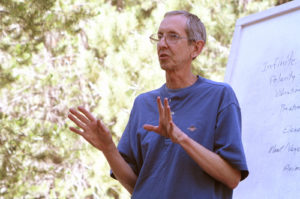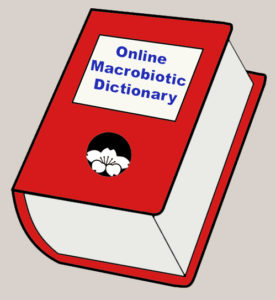
Completed Entries
Freedom from disturbance or conflict; a state of calmness or tranquility. In the macrobiotic view, peace is a by-product of health established by using a macrobiotic dietary approach based on whole grains and fresh vegetables and understanding the order of the universe and the unifying principle. “Only those who see that the two sides of all phenomena, visible and invisible, are front and back or beginning and end of one reality can embrace any antagonistic situation, see its complementarity, and help others to do the same, thereby establishing peace and harmony.” Cancer and the Philosophy of the Far East, 155. Peaceful individuals lead to peaceful families and peaceful families lead to peaceful societies, leading to a more peaceful world.
Water from boiled peach leaves used as a sponge bath for dandruff, prickly heat, or ringworm on the scalp or face.
See Cautionary note.
Phosphorus is a yin acid-forming mineral that helps with the building of strong bones and teeth, the growth and development of brain and nerve tissues, the transport of fatty acids, and blood coagulation. Phosphorus deficiency is extremely rare as there are ample sources in both vegetal and animal foods. Vegetal sources of phosphorus include sunflower seeds; beans, especially lentils; whole grains; and sea vegetables. Animal sources of phosphorus include meats, poultry, fish, and dairy products, and it is more easily absorbed than the phosphorus from vegetal foods. Too much phosphorus can lead to muscle problems, an increase in the risk for heart attacks and strokes, diarrhea, and hardening of organs and soft tissue. It also affects the body’s ability to use other minerals effectively. The tendency of consuming too much phosphorus is one of the many reasons macrobiotic theorists recommend eating fewer amounts of animal foods, if at all.
The art of determining character or personal characteristics from the physical features of the face and other parts of the body. “Oriental physiognomy is based on biology, physiology, and embryology. It is useful and amazing. It tells one’s fate by his or her face and bone structure. Macrobiotics teaches the mechanism of such physical formations.” Macrobiotics: An Invitation to Health and Happiness, 5.

Special tool (usually plastic) used to make pickles by pressure. Also called a salad press when used to make salads.
A pickled food is a food that is preserved in a salty brine or an acid such as vinegar. Macrobiotics recommends eating fermented pickles regularly (several times a week to daily). Natural pickling techniques provide healthy bacteria to aid digestion, especially beneficial for digesting whole grains. Pickles used in macrobiotic practice listed from slightly yin to moderately yang include pressed salad, sauerkraut, and vegetables pickled in nuka (rice bran), umeboshi, soy sauce, miso, salt brine, or salt. One of the most popular is takuan pickles—daikon radish pickled in rice bran. Note: Macrobiotic theorists suggest avoiding pickles made with distilled white vinegar because it is often made from synthetic ethanol and/or contains added chemicals or refined sugar.
Water from boiled peach leaves used as a sponge bath for dandruff or ringworm on the scalp or face.
See Cautionary note.
Bundled pine needles used to stimulate the scalp to promote hair growth.
See Cautionary note.
Plantain is a wild plant that is good for asthma, arthritis, stomach diseases, female sexual organ disorders, uterus pain after delivery, heart disease, weak nerves, headaches, brain diseases, sinusitis, and lower back pain. Plantain can be gathered during August in the early morning before the bright sunlight hits it. It is a weed with broad oval leaves and spikes of small greenish flowers. Pull out the whole plant, including the roots and flowers. Wash and dry in a shady place. Store in a paper bag in a cool place.
Wild edible plants are plants that aren’t domesticated or cultivated and are used as food. From a macrobiotic perspective, wild vegetables have a strong life power because in most circumstances they grow in harsh conditions. They are eaten in season, adapted to one’s local environment, rich in minerals, and help strengthen the body. In Do of Cooking, Cornellia Aihara recommends eating one part wild vegetables to three parts domestic garden vegetables. In spring, wild vegetables have a bitter taste and are eaten to counter animal foods (heavy proteins), salt, and oil eaten in winter. Summer wild vegetables have a sour taste that makes it more comfortable to tolerate the hot weather. Spring wild vegetables include dandelion, jinenjo, mugwort, horsetail, aster, bracken, chickweed, wild scallion, thistle, licorice, New Zealand spinach, plantain, and pigweed. Summer wild vegetables include beefsteak leaves, goosefoot, wood sorrel, purslane, and wild ginger.
“A plaster refers to a paste-like mixture spread on a cloth and applied to the body, or applied directly on the skin without a cloth, to provide relief or to help remove toxins from the body. Among macrobiotic followers, use of an albi [taro] plaster is the most popular way to help remove toxins from the body; the tofu plaster is most often used to help reduce fever and to alleviate headaches and other head problems.” Natural Healing from Head to Toe, 187. The following plasters are used as needed in macrobiotic practice.
See Cautionary note.
Apple plaster: Finely grated apple (peel included) spread on cheesecloth and applied to the head or other body part. An apple plaster is useful for headaches, including migraine headaches with no fever, and heart palpitations. Any apple variety may be used.
Buckwheat plaster: Buckwheat flour mixed with hot water to make a paste-like consistency that is applied directly to the skin over an affected area. The main function of a buckwheat plaster is to remove excess water from the body. Buckwheat plasters also help remove toxins from the body, reduce swelling, and relieve pain.
Buckwheat plaster with salt: Buckwheat flour mixed with salt and hot water to make a paste-like consistency that is applied directly to the skin to help relieve arthritis pain.
Carp plaster: Ground meat from a fresh carp mixed with enough flour to make a paste-like mixture and applied to the chest for the specific purpose of reducing very high fevers, especially in cases of pneumonia. It is never used for mild fevers.
Chlorophyll Plaster: Any ground up green leaves (daikon greens are considered most effective) and unbleached white flour made into a paste-like consistency and placed on the forehead for high fevers or anywhere there is inflammation. For fevers, chlorophyll plasters are a suitable yet weaker substitute for tofu or albi plasters.
Daikon plaster: Grated daikon radish placed on cheesecloth or wrapped in a cotton cloth and applied to the body. It is used mostly for heart diseases, flu, and bruises.
Daikon plaster with ginger: Grated daikon mixed with grated ginger used specifically for ringworm anywhere on the body other than the head.
Garlic plaster: Grated garlic wrapped in cheesecloth and applied to the heel in cases of chills (shivering).
Green Plaster: Any dark green vegetable, peppermint leaves, and unbleached white flour made into a paste-like consistency and placed on a painful area. A green plaster is useful for sprains, especially sprained ankles, eardrum pain, and inhibited breast-milk flow.
Lotus root plaster: Grated lotus root, ginger, and white flour made into a paste-like consistency and used to dissolve mucus from the chest, throat, or sinuses.
Miso plaster: Barley, soybean, or rice miso used as a plaster for bleeding from cuts or for swelling.
Mustard plaster: Dried mustard powder, white flour, and warm water made into a paste-like consistency and mainly used to stimulate circulation and dissolve stagnation.
Potato plaster: Grated potatoes and white flour made into a paste-like consistency and used as a taro plaster when taro is unavailable.
Potato-chlorophyll plaster: Grated potatoes, crushed green leaves, and white flour made into a paste-like consistency and used as a taro plaster when taro is unavailable.
Rice bran plaster: Rice bran (nuka) and water made into a paste-like consistency and used for inflamed hands or feet or broken bones.
Rice plaster: Cooked white or brown rice used as a plaster for sprained ankles or bruises.
Soba plaster: Buckwheat flour and warm water made into a paste-like consistency and used for conditions of the bladder and surrounding areas.
Soybean plaster: Soaked and mashed raw soybeans and flour made into a paste-like consistency and used for fevers, pain, or inflammation.
Taro plaster: Taro (colocasia esculenta) is a large-leaved tropical Asian plant known as satoimo in Japan and albi in India. The roots from white (not red) taro are used as a plaster—a paste-like mixture of taro, ginger, and unbleached white flour applied to the body. Taro plasters are used mostly for helping to remove excess toxins from the body and for relieving pain and swelling.
Tofu plaster: Mashed tofu, grated ginger, and unbleached white flour made into a paste-like consistency and used for head wounds and to reduce fevers, relieve pain, and decrease swelling.
Turnip plaster: Grated turnip used as a plaster for bruises.
Umeboshi plaster: Ground umeboshi (including pits) and white flour made into a paste-like consistency and used for eye infections or arthritis.
Umeboshi saké plaster: Ground umeboshi kernels, saké, and white flour made into a paste-like consistency and used for bone marrow disease.
All foods not included as principal foods (whole grains and their products) or secondary foods (fresh vegetables, beans, sea vegetables, fish, fruit, nuts, seeds, fermented foods, and teas) except for refined sugar, which is avoided if at all possible. Examples include animal foods (other than fish), dairy products, and honey.
The foundation of the relative world due to the polarization of the Infinite into yin (expansion) and yang (contraction). These two arms are both antagonistic and complementary to each other. The interplay between them is the origin of magnetism. It is the beginning of pulsation and life itself as these two energies intersect and collide with each other. Thus, yin-yang interaction is the foundation of the finite world (worlds two through seven of the Order of the Universe).
“Yin and Yang are the two arms of One (Infinity).” The unchanging, limitless, constant, and omnipotent world of Oneness produces and nourishes all things both physical and spiritual. Laws one through six are experienced by the five senses and may be analyzed by the mind or scientific instruments. In contrast, the seventh law is a sketch of the ultimate cause of the universe itself. This is the seventh of Seven Laws of the Order of the Universe.
“Yin and Yang are the classifications of all polarization. They are antagonistic and complementary.” This principle is the foundation of the universal dialectic logic. There is nothing that is complementary without antagonism. Yin and yang are the two arms of Oneness (Infinity) that create, sustain, destroy, and produce anew everything that exists in the finite world. Without conflict harmony has no meaning. Without contradiction there is no agreement. This is the sixth of Seven Laws of the Order of the Universe.
Cornmeal.
Potassium (K) is a yin alkaline-forming mineral that the body relies on for proper functioning. Potassium helps regulate the heartbeat, fluid balance, muscle contractions, and nerve signals. It also helps reduce blood pressure and water retention, aids in the formation of glycogen from glucose and fats from glycogen, and makes oxidation faster when food is metabolized. The guideline is 4,700 milligrams (mg) per day and people eating a typical American diet often don’t reach this goal because potassium is not high in animal foods. Signs and symptoms of potassium deficiency include digestive problems; weakness and fatigue; muscle cramps, aches, or stiffness; breathing difficulties; heart palpitations; and mood changes. A dietary shortage is rare among whole-grain-and-fresh-vegetable eaters because potassium is abundant in vegetables and fruits. Vegetal sources of potassium include most all vegetables, especially cabbage; sea vegetables, especially dulse and kelp; beans and soy products, especially miso; fruits; and nuts.
Macrobiotic theory concentrates on the study of all minerals and, in particular, the proper balance of sodium (yang) and potassium (yin). All living things contain both sodium and potassium and the body is always balancing these two antagonistic yet complementary minerals. The origin of the importance of this ratio in macrobiotics comes from Japanese doctor Sagen Ishizuka around the end of the 19th century. He realized that potassium and sodium salts are antagonistic to each other in function, yet complementary. Potassium salt activates oxidation and sodium salt inhibits it. Potassium salt burns quickly, reducing heat and keeping one cool while sodium salt burns slower, increasing heat and keeping one warm. Ohsawa studied Ishizuka’s dietary theory for many years and changed potassium-sodium proportion to yin-yang proportion and named his philosophy “macrobiotics” with potassium as yin and sodium as yang. Ohsawa felt the ideal potassium-sodium ratio is around 5:1—a ratio over 5:1 is yin and a ratio under 5:1 is yang. For example, the potassium/sodium ratio of egg is 1:1, brown rice 5:1, and potato 512:1. Because macrobiotics emphasizes eating lots of potassium-rich vegetables (yin), these are balanced by yang cooking methods of heat, time, pressure, and salt.
Grated potatoes and white flour made into a paste-like consistency and used as a taro plaster when taro is unavailable.
See Cautionary note.
Grated potatoes, crushed green leaves, and white flour made into a paste-like consistency and used as a taro plaster when taro is unavailable.
See Cautionary note.
George Ohsawa targeted these three vegetables as among the most yin and thus to be absolutely avoided by persons with a yin sickness, any weakened condition, or during pregnancy. This led to a misconception that potatoes, tomatoes, and eggplant (among others) should never be eaten. Ohsawa also mentions that potatoes, tomatoes, and eggplant were recently introduced from tropical climates to temperate ones and thus are foreign to the constitutions of people living in temperate zones. They also are nightshade vegetables from the Solanaceae family that some people claim may contribute to bowel or autoimmune problems. In current macrobiotic practice, no foods are “forbidden,” including potatoes, tomatoes, and eggplant. If prepared with sea salt using macrobiotic principles, potatoes, tomatoes, and eggplant are enjoyed on occasion. In addition, they can help counter the effects of meat toxins, especially for people beginning macrobiotics who have eaten a lot of animal foods in the past.
Ohsawa’s shortcut to Oneness (the Infinite), borrowed from Christian Bible teachings; namely, contemplation on the Order of the Universe and eating and drinking only what is necessary, avoiding excesses.
To feel gratitude and have an understanding of nature and the source of life (the Order of the Universe) during pregnancy is considered of fundamental importance. The destiny of a woman’s child is partly determined by the foods she eats and thoughts she thinks during pregnancy. Experience shows that it’s best not to make major changes in diet during pregnancy.
The beginning of all subatomic particles as the two arms of Oneness continue to interact not only with each other but also with the waves of the world of vibration. Examples of antagonisms and complementaries include centrifugal and centripetal force and solid and gaseous. This is the fourth world of the Order of the Universe.
Pressure cooking is a food preparation method by which foods are subjected to higher pressure than normal atmospheric pressure making them more condensed (yang). Thus, pressure cooking is considered slightly yang and more appropriate in colder (more yin) climates and seasons. All cooking methods result in some loss of nutrients like vitamins C and B1; however, pressure cooking is seen as a net-positive cooking method because of the increased digestibility of protein, fiber, and starch and the increased bioavailability of essential minerals. In the early days of macrobiotic practice in America, pressure-cooked short grain brown rice was considered a primary food to be eaten daily. In more recent years this has changed with greater variety of whole grains being encouraged and more use of boiling grains, especially in warmer (more yang) climates and seasons. The macrobiotic recommendation is to buy stainless steel or enameled ware rather than aluminum, especially for cooking acidic foods that can leach some of the aluminum into the food. Full information on using a pressure cooker may be found in Julia Ferré’s Basic Macrobiotic Cooking, pages 38-41.
Ohsawa adored French philosopher Lucien Lévy-Bruhl’s concept of primitive mentality. After reading his books, Ohsawa traveled to France and was shocked to find that people in the West regarded the traditional “primitive” wisdom of the Far East as completely incomprehensible. Ohsawa writes: “The fundamental philosophy of the non-civilized primitive peoples was very simple: Accept everything gratefully and without the slightest protest. It was modesty, unconditional humiliation [humility], the ‘me’ recognized as the smallest, the most miserable, the most ignorant, the most criminal, the most miserly. Without such understanding, no human being can attain awareness of the true Self (Oneness).” New translation from the 1990 French edition of Cancer and the Philosophy of the Far East—found in the current English edition on page 89.
One of Ohsawa’s main teachings in the dietary realm is that whole grains should be the principal or main food of one’s diet. The return to a diet based on natural whole grains as one’s principal food is the secret of improving one’s natural immunity or healing power. “Only whole grains are meant to be used as principal foods…they form the foundation of a macrobiotic way of eating because they are a combination of both seed and fruit, are abundant on the Earth, and are a most economical, ecological, and nutritious food.” Essential Ohsawa, 19.
A protein is a major nutrient found in food that is essential for growth and repair of cells. Proteins are the building blocks of the body and are the primary solid constituent of enzymes, hormones, blood, body tissues and muscles, and cellular fluids. Scientists view protein as a major energy source and tout animal foods as the main/best dietary source while macrobiotic theorists prefer vegetal sources primarily because animal sources are also high in fat. The macrobiotic view is that animal foods are not necessary, although they may be eaten in small amounts as needed or for pleasure from time to time. Complex carbohydrates are the main source of energy in a macrobiotic dietary approach. Vegetal protein sources include whole grains eaten with beans; soyfoods like miso, shoyu, or tofu; or gomashio (sesame salt). Other good sources of vegetal protein include nuts and seeds. When animal foods are eaten in macrobiotic practice, white-meat fish is most common followed by other fish, chicken, and turkey.
The current average recommended daily amount of dietary protein as determined by the United States Department of Agriculture and the World Health Organization is 0.8 grams per kilogram of body weight, which corresponds to 0.36 grams per pound. This amounts to 54 grams for a 150 pound person. The best amount for each person is adjusted depending on many factors including activity level, age, personal goals, and current health status.
When proteins are consumed, various enzymes and hydrochloric acid present in the gastrointestinal tract break them down into simple amino acids and then the body uses these components to synthesize new protein molecules to be used to form red blood cells and then body cells. Proteins are more yin than carbohydrates but more yang than fats. Protein metabolism is helped by vitamins A, C, D, E, K, and B-complex.
Deep-fried puffed dough, often filled with vegetables as a staple sandwich in India.
Macrobiotic principles can be used for physical purposes such as strengthening health or improving natural immunity, mental purposes like improving judgment or elevating consciousness, and spiritual purposes such as becoming spiritually free or realizing one’s true Self. Having a clear understanding of one’s purpose allows one to choose the most appropriate lifestyle and dietary choices for that purpose.
Projected Entries
Pain
Pain killers
Palm healing (or hand healing)
Pancreas
Pan-fry
Paralysis
Paranoia
Parasites
Parboil
Parkinson’s disease
Pasteurization
Pathological calcification
Pearled barley
Pellagra
Perception
Perennial philosophy
Periostitis
Peritonitis
Phenylalanine
Philosophy, Far Eastern
Pickles
Pituitary gland
Plums
Pneumonia
Polio
Polysaccharides
Polyunsaturated fats
Pork
Potimarron
Prayer
Pressed salad
Pressure cooker
Pressure points
Prolapus
Protruding stomach
Pro-vitamin C
Protein cycle
Pumpkin, Hokkaido
Purée
Pyorrhea
Pyrosis (over-acidity)
Pyruvic acid
Questions or Comments?




